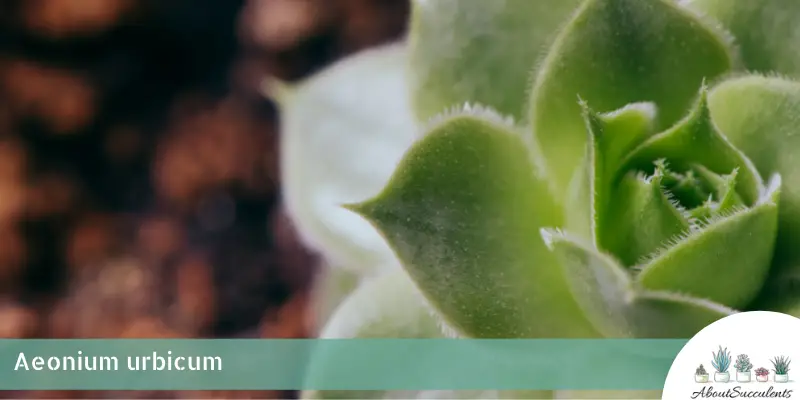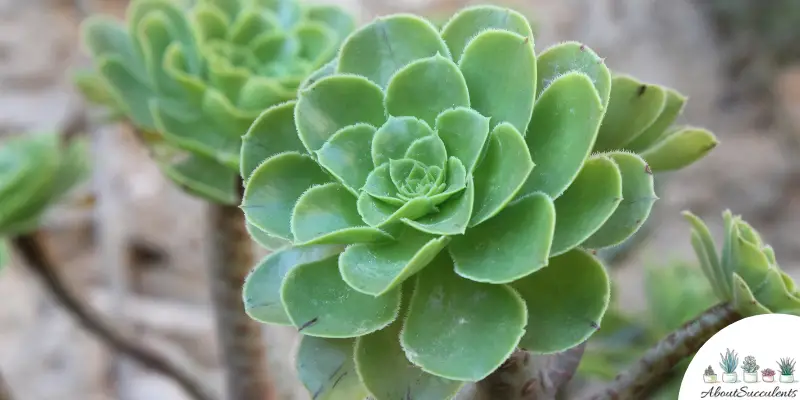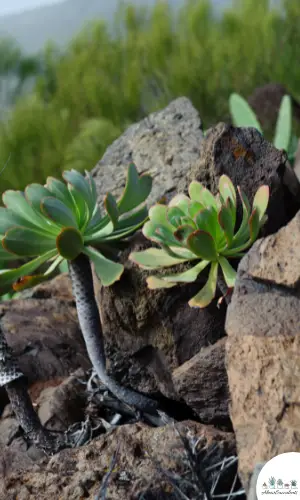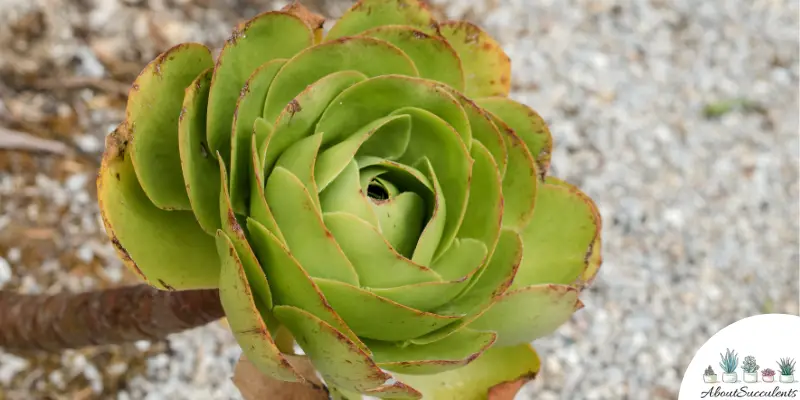
Aeonium urbicum is a delightful succulent that will perk you up whenever you’re having a bad day. Also known as “Saucer Plant” and “Salad Bowl”, it’s easily recognizable by its thick, fleshy, lime green-colored leaves that develop dark red-tinged tips when given direct sunlight.
The leaves will form a tight rosette that when viewed from the side gives the impression of your garden having tall, bright green pinwheels. These rosettes can grow fairly large – up to 20-inches (50.8cm) in diameter.
Likewise, Saucer Plant can become a tall succulent that reaches a height of 6-feet (1.82m) when planted outdoors. In the summertime, Aeonium urbicum will bloom hundreds of small, star-shaped flowers that vary in color from white to pink.
However, Aeonium urbicum is monocarpic which means the succulent will die after it produces flowers.
Saucer Plant is a member of the Crassulaceae family and is native to the Tenerife which is one of the Canary Islands.
General Information
Also known as: Salad Bowl, Saucer Plant
Plant Family: Crassulaceae
Origin: Tenerife, Canary Islands
Height: 6-feet (1.82m)
Exposure: Partial to full sun for up to 6 hours per day; direct sunlight is recommended to attain the leaves’ red-colored tips.
Water Needs: Drought-tolerant; only water the soil when it’s completely dry.
Soil Type: Sandy loam, cactus, or succulent mix with added ingredients such as perlite, pumice, coarse sand, and lava rocks for better drainage.
Soil pH: 6.1 to 6.5
How to Grow and Care for Aeonium Urbicum

Aeonium urbicum is a no-fuss succulent plant to grow and care for. If you grew other species of plants and found yourself mothering them every day with water, caring for succulents will be different. Instead of being an attentive mother to Saucer Plant, you have to practice neglect.
Succulents have grown in popularity over the last few decades because people don’t have to worry about the plants’ needs on a daily basis. Once they’re nestled in place, that’s it. You can check in on them once a week or every 10 days depending on the season.
But there are some things that you have to be aware of to ensure that Salad Bowl will continue to have salad days.
Sunlight
Aeonium urbicum will grow healthy whether you give it partial or full sunlight. As earlier mentioned, to get the red-colored tips, direct sunlight would be better. Just remember to protect Saucer Plant from the mid-afternoon sun. The rays are much hotter and the precious lime green leaves will get sunburned.
Because Aeonium urbicum is a tall succulent, it might be a good idea to plant it in your outdoor garden. Place it in an area that gets 6 hours of sunlight every day.
If you prefer that Saucer Plant becomes an indoor conversation piece, display it near a window that gets 6 hours of partial sunlight on a daily basis.
It would be a good idea to grow Aeonium urbicum in a pot that can be transferred indoors if the temperature in your area drops below 20° F (-6.7° C) as this succulent isn’t cold-hardy.
It’s important that Salad Bowl gets its regular dose of the sun’s rays. Otherwise, the succulent will undergo the process of etiolation whereby the leaves stretch out as if looking for sunlight. The leaves will lose their shape, wither, and eventually, die.
Water

Aeonium urbicum doesn’t enjoy dry, arid conditions. You might notice that during dry, hot weather, the succulent’s leaves start to curl up. Saucer Plant does this to preserve water.
Thus, compared to other varieties of succulents, you have to pay more attention to Salad Bowl’s watering schedule.
The first rule in watering Aeoniums is to check if the soil is completely dry. You can do this by inserting your finger or a stick an inch into the topsoil. If it feels dry, the soil is ready to get drenched in water.
The second rule in watering Aeoniums is to always water the soil and not the plant itself. Yes, the plant needs water but you can’t let it retain moisture for a long time.
If the soil stays moist for a prolonged period, bacteria can develop. The roots of Saucer Plant can rupture and provide an entry for the fungi to contaminate the entire plant. Thus, expect to water the soil more during summer and less in the winter.
Pot and Soil
For Aeonium urbicum, a pot made of unglazed ceramic or terracotta would be the best choice because it allows moisture to escape faster from the soil.
Choose a pot that’s slightly bigger than the base of the plant to enable the roots to grow without getting entangled and to support proper soil aeration. The pot must have a drain hole at the bottom to filter out excess water.
Unlike other species, Saucer Plant needs a bit more moisture in the soil. Instead of cactus soil which dries out very quickly, sandy loam would be a better choice as it retains moisture a while longer. Add perlite to still assure proper drainage takes place. For an outdoor succulent, add peat moss to the soil.
How to Propagate Aeonium Urbicum

If you want to have a salad buffet in your outdoor garden, all you have to do is propagate Aeonium urbicum and there are 3 methods to choose from: Stem cuttings, leaves, and offsets.
Stem Cuttings Method
Step 1: If the leaves of Saucer Plant have been damaged by frost, choose a healthy stem that’s growing near the main plant.
Step 2: With a sterilized and sharpened knife or garden shears, cut a small section of the stem – approximately half an inch in diameter.
Step 3: Place the cuttings in a dry area and give it 2 to 4 days to develop calluses.
Step 4: Once the cuttings have callused over, place them on top of well-draining sandy soil. Make sure the cuttings are properly spaced apart.
Step 5: Lightly moisten the soil with water and place the pot near a window that gets 4 to 6 hours of partial sunlight.
Step 6: Water the soil sparingly or only when it’s 100% dry once the roots have fully formed.
Leaves Method
Step 1: Remove a healthy leaf from the stem by performing a smooth twist and pull. If a part of the leaf remains on the stem, propagation won’t be successful. If this happens, repeat the process.
Step 2: Leaves aren’t as sensitive as stem cuttings. You only have to wait for the pulled ends to develop calluses before planting them. This might take only 2 days at most.
Step 3: When the leaves are ready, place them on top of sandy soil and water the soil lightly. Move the pot near a window that gets 6 hours of partial sunlight.
Step 4: If the leaves have taken root, water the soil whenever it’s completely dry.
Offsets Method
Step 1: Aeonium urbicum grows offsets once a year. These offsets grow near the base of the plant. You can remove the offsets when they’re 12 to 14-inches (30.48 to 35.56cm) tall.
Step 2: Use a sharp knife or garden shears to remove the offsets from the plant. Make sure the roots are intact.
Step 3: Let the offsets dry out for a few days or until it has calluses.
Step 4: Plant the offsets in sandy soil. Lightly water the soil frequently and place the pot near a window that gets 6 hours of sunlight.
Step 5: The offsets will grow their own root system. Once this happens, only water the soil when you’ve tested its level of dryness.
Frequently Asked Questions
Is Aeonium Urbicum Toxic to Cats and Dogs?
Aeonium urbicum doesn’t appear on the list of plants toxic to cats and dogs that appear on the website of the American Society for the Prevention of Cruelty to Animals (ASPCA).
However, the list is incomplete and Saucer Plant has been reported to have caused cats and dogs to fall ill after ingesting parts of it.
If you notice your pet undergoing distress and exhibits symptoms such as vomiting and loss of appetite, bring the animal to the veterinarian immediately.
Why is My Aeonium Urbicum Dying?
Aeonium urbicum’s health can be compromised by 2 factors: Overwatering and pest infestation.
Overwatering
You know that root rot has occurred if you notice the leaves and stems of Aeonium urbicum developing yellowish-brown or blackish spots.
When you see these spots, get a sterilized pair of garden shears or scissors and remove these infected sections right away to keep the fungi from spreading. Remove Saucer Plant from the soil and cut off all of the infected roots.
While Saucer Plant is drying out, fill up a new pot with sandy loam. Replant Aeonium urbicum and give the plant a few days to adjust to its new home before watering the soil.
Pest Infestation
Aeonium urbicum attracts pests such as whiteflies, mealybugs, and aphids. These pests will make Salad Bowl’s leaves their home. At the same time, these pests will freeload on your succulent’s sap.
Remove any white residue you find on the leaves and spray Salad Bowl with neem oil to keep pests away.
Yes, Aeonium urbicum produces hundreds of small, star-shaped flowers that range in color from white to pink in the summertime.
Last Updated on June 9, 2022 by Sofia Lara